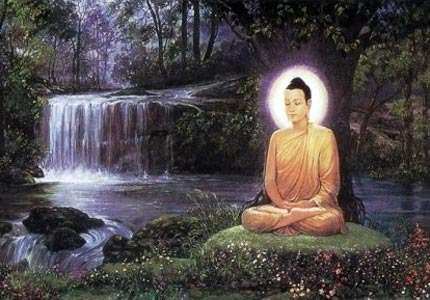|
Buddhism is a growing religion in the west, and
it has even become a bit fashionable. It preaches non-violence, offers methods
of meditation and insight in who we are. The Dalai Lama keeps touring the
world spreading Buddhist ideals. When the Dalai Lama visited my town, Woodstock,
NY, there was a non-scheduled, unannounced visit in the village of Woodstock,
around 2000 people showed up for his talk. Buddhism has a lot of good stuff
to offer. You can find a couple of articles based on Buddhist philosophy
in my House of the Sun section. However, over the years I have learned that
the Buddhist monasteries seems to be quite different than what I had preciously
thought. Whenever religion turns into monasteries with hierarchies, titles,
churches, inner and outer circles, financial dealings and political plays,
their members fall too often prey to human weaknesses. There are plenty
of examples that have seen the light in the news media over the past decades.
What I understand about the Buddhist monasteries is the organizational structure
of Tibetan Buddhism which has similar characteristics to any other religious
organization. What I am seeing is that people do not really understand what
Buddhism is about. There is a big difference between the Buddhist traditional
teachings and the Buddhism hierarchical structure in the form of monasteries,
monks, lama's etc. What I will talk about here is my own critical observations
about the Buddhist monasteries, not about the Buddhist teachings. I like
the Buddhist teachings very much. They have a lot to offer and are very
helpful for a lot of people. I certainly have learned a lot from Buddhism,
as well as from Christianity (=teachings of Jesus Christ). I should also
mention that within any religious organization there are also lots of good
people working for the benefit of humanity.
If you are interested in
Buddhism, I believe you should not only read all the good stuff, but also
the dark side of the Buddhist monasteries. Avoiding and ignoring the dark
side is a major stumbling block on the spiritual path. The dark side is
always painful and therefore too often unrecognized. It is important to
recognize where the Buddhist practitioners are failing, and a lesson is
to be drawn for the present and future.
I once read that the reason why
China invaded Tibet (from the spiritual point of view) is that the Buddhist
hierarchical monasteries had become completely stuck, rigid and self serving.
Higher powers intervened and the Buddhist practitioners were forced to move
out into the world. I think a lot of those Buddhist leaders still don't
get it that the structures they created in the old Tibet were clearly wrong
from the spiritual, Buddhist point of view.
I live here in Woodstock,
NY. Up the mountain is the Karma Triyana Dharmachakra, the North American
seat of His Holiness the Gyalwa Karmapa, head of the Karma Kagyu school
of Tibetan Buddhism. Founded in 1976, the monastery features traditional
teachings as transmitted by Kagyu lineage meditation masters since the 10th
century. Keep in mind the Karmapa term, as I will speak about this later
on. Fourteen years ago I spent about a month up there. At that time only
the main temple building existed (now they are building extensive living
quarters for monks and guests), plus an old hotel building that served as
the housing quarters of about a dozen Americans who live and work on the
property. In the hotel building is also the Buddhist shop and kitchen area
for both Americans and the monks/lamas.
When I was staying on the property,
I helped the Tibetan master painter paint the main temple, which houses
a large statue of Buddha, among smaller other statues and scrolls. I must
say I absolutely adore this main, large shrine room. It is a marvel of art.
Words does not do it justice, you just have to be there. I also spent time
alone in there, in the evenings to meditate. The energy of the room is amazingly
positive, it felt like home to me. I still feel that way. I am convinced
it was built on a power spot, just like the European cathedrals and churches
were.
You have to understand me well: I like the temple building, and
I have nothing against the teachings being given there. But here is what
I find disturbing. The staff, which lived in the hotel building, consists
mainly of people who had become homeless. At the monastery they had a place
to live in return for work on the monastery. Ok, nothing wrong with that,
one needs a place to live. But what I don't like like is the attitude that
they, like so many other people/visitors have towards the monks and lamas.
I first discovered this when helping out in the kitchen. The three lamas
of the monastery and their family members had separate tables, and those
tables had a special elaborate dining set. This fork had to be exactly positioned
this way, and that spoon that way. Like the King of Siam came to visit.
When they came into the dining room, everybody was overly polite to them,
treating them as untouchables. That didn't sit well with me. Lamas and monks,
regardless of their self-proclaimed ranks, are just like everybody else,
human beings on the path to the discovery of the divine self. The Buddhist
teaching say that we are all the same, we are all equal. Isn't it part of
the Buddhist teachings to be detached of the ego and worldly affairs? To
live in simplicity? In stead they are being treated preferentially, what
is mostly the fault of the Westerners. I notice that some people who visit
the Buddhist monastery look at the lamas as if they are semi-gods. This
is a pitfall for most authority figures, like priests, swamis, gurus etc.
The lamas of course like it, it is their power. Being treated like undisputable
masters, they take advantage of their simple minded disciples who they see
as cheap labor. (Their monasteries are built largely by volunteers and with
donated money.)
Here is another thing I stumbled upon. I spoke with
some of the carpenters who were working in the basement. They were hand-making
special cabinets from the finest wood for the private quarters of the lamas.
Well, Buddha gave up his wealth and luxurious living in his palace, and
lived a basic, simple life. Is a wal-mart closet not good enough? I was
shown a door that gave access to the stairway leading to the second floor
where the lamas private quarters where. "Absolutely forbidden to go
there!" I do understand the need for privacy. But you know, I am an
open minded Aquarius for something, so I peeked into the corridor. Maybe
I am too critical, but I was shocked at what I saw, that the corridor has
fancy carpeting and many very nice beveled glass chandeliers. Isn't there
a better way to spend that money? Like helping hungry people in the community?
Meanwhile the staff in the old hotel (where I was staying) were sleeping
in bunk beds, up to six in a bare room. There was only enough warm water
for about three people to take a shower in the morning, the rest got cold.
Do you understand what I am getting at? At one side you have the Westerners
who idolize the Buddhist monks and lamas who still cling to their hierarchical
positions, getting preferential treatment and cashing in on a lot of money
and labor. Their sole existence depends on the donations and money from
teachings, books and publications. Ok, one does need an income, but look
at it as a financial organization. Is that what Buddhism is about? Jesus
threw the Pharisees (who were merchants) out of the temple because "they
don't have a place in the House of the Lord".
Sometimes I think
I am a little bit too critical. But somebody else made the same observations: "The
monks who were granted political asylum in California applied for public
assistance. Lewis, herself a devotee for a time, assisted with the paperwork.
She observed that they continue to receive government checks amounting to
$550 to $700 per month along with Medicare. In addition, the monks reside
rent free in nicely furnished apartments. “They pay no utilities, have free
access to the Internet on computers provided for them, along with fax machines,
free cell and home phones and cable TV. They also receive a monthly payment
from their order, along with contributions and dues from their American
followers. Some devotees eagerly carry out chores for the monks, including
grocery shopping and cleaning their apartments and toilets. These same holy
men, Lewis remarks, “have no problem criticizing Americans for their obsession
with material things." (Friendly Feudalism: The Tibet Myth)
By the way, Buddhist monasteries in Tibet were not unfamiliar with
accumulating wealth. (Ay, here comes the dirty laundry) Until 1959, when
the Dalai Lama last presided over Tibet, most of the arable land was still
organized into manorial estates worked by serfs. These estates were owned
by two social groups: the rich secular landlords and the rich theocratic
lamas. Even a writer sympathetic to the old order allows that “a great deal
of real estate belonged to the monasteries, and most of them amassed great
riches.” Much of the wealth was accumulated “through active participation
in trade, commerce, and money lending.” Drepung monastery in Lhasa was one
of the biggest landowners in the world, with its 185 manors, 25,000 serfs,
300 great pastures, and 16,000 herdsmen. The wealth of the monasteries rested
in the hands of small numbers of high-ranking lamas. Most ordinary monks
lived modestly and had no direct access to great wealth. The Dalai Lama
himself “lived richly in the 1000-room, 14-story Potala Palace.” (Friendly Feudalism
by Michael Parenti)
At present, Buddhist monasteries are still rich. The Karma Kagyu sect
has assets worth over 1.2 Billion dollars. When the Dalai Lama comes to
Los Angeles, he stays in the Presidential Suite at the Huntington Ritz-Carlton
Hotel, which normally rents for $3000 a day.
I used to live in Belgium.
There are plenty of Christian monasteries over there, and many different
fraternities. Most of the fraternities are very active in giving support
to whoever needs it. I once visited the fraters of the Abbey of Norbertynen
in Grimbergen near Brussels. Part of their duty is to go out into the world
and visit elder and sick people to support them in whatever way they can.
I once visited a small abbey church in Brussels. I sat down in the middle
of the rows of seats. there were only two or three other people present.
After a couple of minutes a frater walked up to me asking if I needed to
talk, and if everything was ok. You see, that is true spirituality. In Buddhism,
it is emphasized that there are two things to do on the Buddhist path: meditation
to cultivate the clear, present awareness, AND the Bodhisattva ideal.
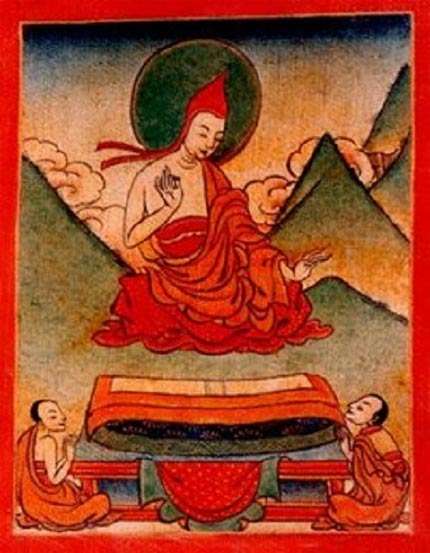
Master Shantideva - 695-743
AD,
the great proponent of the Bodhisattva Ideal and the Middle Way
of Buddhism
The bodhisattva ideal is embodied in the bodhisattva
vow: "May I attain Buddhahood for the benefit of all sentient beings."
This practically means that one vows not just to attain enlightenment or
Nirvana, but to postpone enjoying that enlightenment fully until all other
beings too have reached liberation. This does not mean that one waits until
he is at the doorstep to enlightenment to help people. Normal people's (and
thus monks and lamas too) own quest for enlightenment is very closely commingled
with works of compassion for others. The Bodhisattva ideal is to actively
help your fellow man in any way you can, on practical level. Within the
Mahayana tradition, compassion for the suffering of others tends to be a
higher priority than liberation for one's self. Or, more properly put, focus
on compassion is understood to be one of the most powerful vehicles to facilitate
liberation, both for others and for one's self. Since, after all, being
concerned with the welfare of others diminishes selfishness, Mahayanists
understand the cultivation of compassion to be one of the best ways towards
the elimination of ego, desire, and suffering for one's self.
I mentioned
the practice of clear, present awareness, the essence of any Buddhist path.
The other day, my wife and I went to visit the Buddhist monastery up the
mountain again. We were talking with one of the staff members, when this
woman introduced us to a lama from another nearby monastery. My wife showed
some pictures of her Tara paintings. I just could not believe my eyes. That
lama didn't connect at all with us, looked briefly at the pictures but didn't
actually see them, and was looking in all directions. His mind was scattered
all over of the place, and he excused himself after less than a minute to
join somebody else. Well, the term lama and its hierarchical position doesn't
mean anything to me. Most ordinary people I know are a hundred times more
focused than he is. And then the woman proceeded to tell us how important
it was the we had met that lama, and it was a connection of profound significance
for our lives.
Well, nobody is perfect, and there are always positive
and negative sides to people and monasteries. I just want to give you some
reflections on Buddhism as a lot of people nowadays feel drawn to it. On
the same visit, my wife gave a woman/visitor a card of one of her Tara painting.
The woman was not only overly polite, but she gave the picture to one of
the monks to pass it on to the head lama to bless it. Why does one need
a blessed picture for? It reminds me of the story in one of Alexandra David-Neel's
books. Alexandra was traveling through Tibet (first part of the nineteen
hundreds) when a procession came by of a high ranking lama bestowing blessing
upon the local people. A hermit (spiritual practitioner) from the mountains
stood next to her. He laughed at the whole procession. Alexandra asked why
he laughed. He told her that people are stupid to believe that the lama
was transferring blessings to them, as he clearly could see (as his spiritual
eye was opened) that the lama could not.
I have given you some of my
personal observations and opinions, but there is more. Remember that I said
to keep in mind the term of Karmapa. It just happens that the monastery
in Woodstock here is the official seat of the Karmapa. You won't hear it
at the monastery, but there is a whole controversy around the Karmapa. But
first I have to explain something else. (the following is based on information
found on other websites).
Tibet in the past centuries was not a happy
country. There were several lineages and monasteries ruling their "territories"
and monopolizing the country's wealth by exacting tribute and labor services
from peasants and herders. This system was similar to how the medieval Catholic
Church exploited peasants in feudal Europe. Tibetan peasants and herders
had little personal freedom. Without the permission of the priests, or lamas,
they could not do anything. They were considered appendages to the monastery.
The peasantry lived in dire poverty while enormous wealth accumulated in
the monasteries and in the Dalai Lama's palace in Lhasa. For hundreds of
years in Tibet, lay followers of each religious school clashed with each
other for control of the government of central Tibet or rule over provincial
areas. Lamas had to defend their monasteries and landholdings from supporters
of the other schools as well as from the central government. (Life in Tibet
before the Chinese invasion was really bad for ordinary people). In 1956
the Dalai Lama, fearing that the Chinese government would soon move on Lhasa,
issued an appeal for gold and jewels to construct another throne for himself.
This, he argued, would help rid Tibet of bad omens'. One hundred and twenty
tons were collected. When the Dalai Lama fled to India in 1959, he was preceded
by more than 60 tons of treasure.
Most people think that the Dalai lama
is the head of state of Tibet. But this is not quite true. Tibet has four
main Buddhist sects (lineages): Nyingma, Kagyu, Sakya and Gelug (and a couple
of minor ones). The Dalai lama was the head of only one of them: the Gelug
sect, also know as the Yellow Hats. His lineage was politically powerful,
and he traditionally claims to be the head of state of the whole of Tibet.
The Gelug sect took control over the region of Tibet in the 17th century,
becoming a political center. The other Buddhist sects don't always recognize
the Dalai Lama as their leader.
Where does the idea of "Dalai Lama"
come from? In the thirteenth century, Emperor Kublai Khan created the first
Grand Lama, who was to preside over all the other lamas as might a pope
over his bishops. Several centuries later, the Emperor of China sent an
army into Tibet to support the Grand Lama, an ambitious 25-year-old man,
who then gave himself the title of Dalai (Ocean) Lama, ruler of all Tibet.
His two previous lama “incarnations” were then retroactively recognized
as his predecessors, thereby transforming the 1st Dalai Lama into the 3rd
Dalai Lama. This 1st (or 3rd) Dalai Lama seized monasteries that did not
belong to his sect, and is believed to have destroyed Buddhist writings
that conflicted with his claim to divinity. The Dalai Lama who succeeded
him pursued a self-indulgent life, enjoying many mistresses, partying with
friends, and acting in other ways deemed unfitting for an incarnate deity.
For these transgressions he was murdered by his priests. Within 170 years,
despite their recognized divine status, five Dalai Lamas were killed by
their high priests or other courtiers. For hundreds of years competing Tibetan
Buddhist sects engaged in bitterly violent clashes and summary executions.
In 1660, the 5th Dalai Lama was faced with a rebellion in Tsang province,
the stronghold of the rival Kagyu sect with its high lama known as the Karmapa.
The 5th Dalai Lama called for harsh retribution against the rebels, directing
the Mongol army to obliterate the male and female lines, and the offspring
too. In short, annihilate any traces of them, even their names. In 1792,
many Kagyu monasteries were confiscated and their monks were forcibly converted
to the Gelug sect (the Dalai Lama’s denomination). The Gelug school, known
also as the “Yellow Hats,” showed little tolerance or willingness to mix
their teachings with other Buddhist sects. An eighteenth-century memoir
of a Tibetan general depicts sectarian strife among Buddhists that is as
brutal and bloody as any religious conflict might be. This grim history
remains largely unvisited by present-day followers of Tibetan Buddhism in
the West.
When the Tibetans reorganized themselves in India after the
invasion of the Chinese, the Gelug sect exercised their power once more.
They wanted to make a unified Tibetan community, of course under their control.
The United Party was a plan run by the Dalai Lama's brother Gyalo Thondup
to unite all Tibetans, regardless of their region or religious affiliation,
into a coherent group able to stand together against the Chinese. The most
controversial part of the plan was a scheme to combine the four Buddhist
schools and the Bon religion (governed separately for more than five hundred
years back in Tibet) under a single administration led by the Dalai Lama.
When word of the United Party's religious reform got out in 1964, the exiled
government was unprepared for the angry opposition that leaders of the religious
schools expressed. To them, this unification plan appeared as a thinly disguised
scheme for the exile government to confiscate the monasteries that dozens
of lamas had begun to re-establish in exile with funds they had raised themselves.
You have to remember although the supporters of the Dalai Lama say he is
the religious and political leader of all Tibetans, many Tibetans disagree.
They hold that the four religious schools outside of the Dalai Lama’s own
Gelug governed themselves autonomously back in Tibet; and that they continue
to run their own affairs today, without reference to the authority of the
Dalai Lama.
Another surprising story is that of their involvement with
the CIA and armed conflicts in Tibet occupied by the Chinese. Throughout
the 1960s, the Tibetan exile community was secretly pocketing $1.7 million
a year from the CIA, according to documents released by the State Department
in 1998. Once this fact was publicized, the Dalai Lama’s organization itself
issued a statement admitting that it had received millions of dollars from
the CIA during the 1960s to send armed squads of exiles into Tibet to undermine
the Maoist revolution (remember Buddhism teaches non-violence). The Dalai
Lama's annual payment from the CIA was $186,000. Indian intelligence also
financed both him and other Tibetan exiles. He has refused to say whether
he or his brothers worked for the CIA. The agency has also declined to comment.
I am just stating here the publicly known facts. Personally I think the
present Dalai Lama was too young at that time, and he probably was under
pressure from the other lamas in the exiled Tibetan government. Since then
he has done many good works. Nevertheless, Tibetan authorities preach non-violence,
but send armed exiles into Tibet to fight?
Let's return to that Karmapa
term. Most people know that the the Dalai Lama is traditionally regarded
as the reincarnation of the previous Dalai Lama. In other words, the same
person keeps on reincarnating. Each time he (as a young boy) is found by
the lamas somewhere in Tibet, and subsequently reinstated as the next Dalai
Lama. This system of repeated reincarnations is the tulku system. A Tulku
is a spiritual teacher, usually the head of a monastery, who chooses to
keep on reincarnating in order to continue to be the leader of the same
monastery.
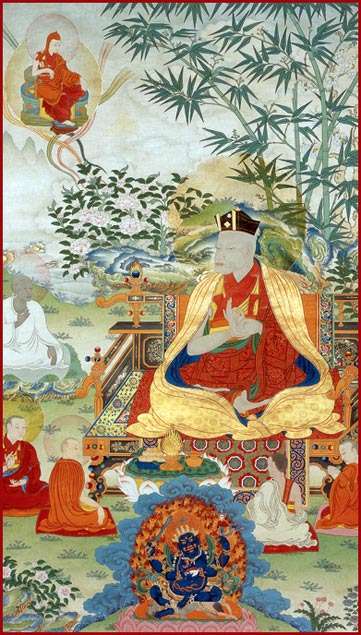
The first Karmapa: Düsum Khyenpa (1110 - 1193)
It should be noted that the Dalai Lama is not the
only highly placed lama chosen in childhood as a reincarnation. One or another
reincarnate lama or tulku--a spiritual teacher of special purity elected
to be reborn again and again--can be found presiding over most major monasteries.
The tulku system is unique to Tibetan Buddhism. Scores of Tibetan lamas
claim to be reincarnate tulkus.
The very first tulku was a lama known
as the Karmapa who appeared nearly three centuries before the first Dalai
Lama. The Karmapa is leader of a Tibetan Buddhist tradition known as the
Karma Kagyu. The rise of the Gelugpa sect headed by the Dalai Lama led to
a politico-religious rivalry with the Kagyu that has lasted five hundred
years and continues to play itself out within the Tibetan exile community
today. That the Kagyu sect has grown famously, opening some six hundred
new centers around the world in the last thirty-five years, has not helped
the situation.
How did the tulku belief system come about? In the twelfth
century, the first Karmapa Dusum Khyenpa predicted that he would return
to teach his students and manage his monastery in his next lifetime. And
sure enough, when Dusum Khyenpa died, his students located a boy who showed
signs that he was the reincarnation of the Karmapa. The boy was named Karma
Pakshi and when he was old enough, he inherited control over the Karmapa’s
cloister and his activities. From then on, the Karmapa’s monastery was relatively
free of control by local noble families. Being able to choose their own
leader, they became masters of their own destiny. Impressed by the success
of this system, other monasteries copied it as a means to choose their own
top lamas. Thus, over a period of a couple centuries, power shifted in Tibet
from landowning families to the lamas who managed the most powerful monasteries.
The most revered tulkus attracted donations and students, developing monastic
empires and political power of their own. As tulkus became major political
leaders in their regions, lama-rule in Tibet reached its apex. In the late
fourteenth century, nearly three centuries after the first Karmapa, the
Dalai Lamas would appear.
The Tulku system was invented by the monasteries
to be able to control their religious/political power by themselves. Outsiders
might think that spiritual masters were always located according to set
procedures laid down to ensure the accuracy of the result—that the child
located would be the genuine reincarnation of the dead master, as in the
scene from the movie Kundun. But in Tibetan history, tulku searches were
not always conducted in such a pure way. Reincarnating lamas inherited great
wealth and power from their predecessors and thus became the center of many
political disputes. Tulkus were often recognized based on non-religious
factors. Sometimes monastic officials wanted a child from a powerful local
noble family to give their cloister more political clout. Other times, they
wanted a child from a lower-class family that would have little leverage
to influence the child’s upbringing. In yet other situations, the desires
of the monastic officials took second place to external politics. A local
warlord, the Chinese emperor or even the Dalai Lama’s government in Lhasa
might try to impose its choice of tulku on a monastery for political reasons.
Only the strongest monastic administrations had the ability to resist such
external pressures, and the Karmapa’s monastery was one of these. Sixteen
Karmapas were recognized by the Karmapa’s own monastery and without participation
from outsiders. Only in one instance, when the sixteenth Karmapa was recognized
in the 1920s, did the Tibetan government of the thirteenth Dalai Lama try
to intervene in choosing a Karmapa. In that case the government ultimately
had to back down.
Soon after the 16th Karmapa arrived in Sikkim, India,
in 1959,
constructions of his Rumtek Monastery began. It served as his
seat outside Tibet and quickly became well known throughout the Himalayan
region because of the Himalayan peoples' devotion to the Karmapa. In contrast
to the Karmapa, most other lamas who fled from China found themselves in
a weak position.
In an effort to unify the Tibetan exiles and thereby
strengthen their opposition against the Chinese government, the Dalai Lama
and his brother Thondrup in 1962 formulated and began to implement a policy
of political, ethnic, and spiritual unity for all Tibetan exiles. Lamas
belonging to the three lineages outside the Gelugpa School supported the
political aspect of this policy but were quite suspicious of its call for
spiritual unity. They feared this would end the traditional independence
of their lineages. Therefore, Nyingma and Kagyu lamas encouraged the Karmapa
to lead a resistance to the Tibetan Government in Exile's policy for spiritual
unity.
For almost two decades the 16th Karmapa (who died in 1981)
actively opposed the Dalai Lama's spiritual unification policy until his
death. This put extreme pressure on the Dalai Lama because over 13 large
Tibetan Resettlements Centers in the Himalayan region unanimously supported
the Karmapa. In addition, all the high Nyingma and Kagyu lamas followed
the Karmapa without question because of his leadership and of the Karma
Kagyu and because generations of repression of the Karma Kagyu by the Dalai
Lama's government left the Karma Kagyu disgusted with it.
Then the sixteenth
Karmapa died in 1981. The sixteenth Karmapa had built the monastery of Rumtek
in the tiny Himalayan kingdom of Sikkim, which became a state of India in
1975. After his death, the four regents in charge of looking for his reincarnation
had trouble finding the boy who would take over. While the Tibetan Buddhist
lineages use various methods for finding the reincarnation of a high lama,
the Karmapa traditionally wrote a letter before he died indicating where
his successor would be found. Eventually in 1992 one of the regents, Tai
Situ Rinpoche, produced a letter which he said had been hidden in a talisman
given to him by the 16th Karmapa. But when regent Shamar Rinpoche saw it
he claimed it was forged, alleging the script was "100 percent Tai
Situ's handwriting".
Shamar, though, was in a minority. His call
for a forensic test of the letter was overridden and the search went ahead.
Tai Situ brought in the Dalai Lama to officially bless the recognition,
which critics say is an unusual step as the Dalai Lama is head of the Gelukpa
Buddhist lineage, not the Karma Kagyu. Their boy was also supported by,
surprisingly, the Chinese government as well. Back in Sikkim, with the help
of local state police and paramilitary forces, these lamas and their followers
took over Rumtek monastery in 1993. The Indian government however does not
allow him to be in the Rumtek monastery, so he lives in Dharamsala (the
headquarters of the Dalai Lama). In 1994, another prominent lama, the nephew
of the deceased Karmapa and the lama whose predecessors had chosen the highest
number of Karmapas in past centuries installed his own boy (Trinlay Thaye
Dorje) in India. Thus began a struggle over the identity of the seventeenth
Karmapa that continues to the present day.
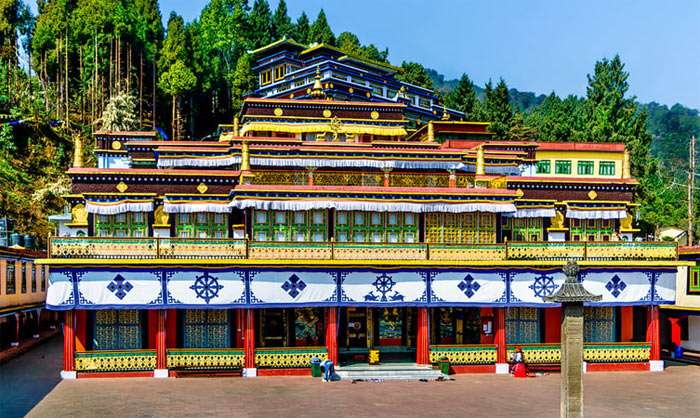
Rhumtek monastery
Thus there are now two Karmapas: Ogyen (or Urgyen)
Trinley Dorje who was approved by the Dalai Lama, and Trinlay Thaye Dorje
who is recognized by Kunzig Shamar Rinpoche, second to the Karmapa in the
Karma Kagyu Lineage. So who is the real one? That has confused a lot of
Tibetan Buddhists. The result is that some monasteries and Buddhist centers
(about 600) take Trinlay Thaye Dorje as their Karmapa, and others (about
200) take Ogyen Trinley Dorje as their Karmapa.
So now we have two Karmapas,
a division in the Kagyu sect, violent clashes between the two and a lot
of confusion. What is so important about the Rumtek monastery that is was
taken over by force? Is it because that besides vast material wealth, the
lama that finally inherits Rumtek inherits the most sacred object of the
Kagyu sect: a magic black hat. Ah, now it gets interesting, who wouldn't
want a magic object? As the story goes, the 1st Karmapa spent many years
meditating in a cave. Ten thousand female deities came to congratulate him
and each offered a strand of hair. These strands were woven into a black
hat. It is said that unless held in the hand or kept in a box the Black
Hat will fly away. It is said that when the Karmapa places it on his head,
he has to hold it down with his hand to prevent it flying away.
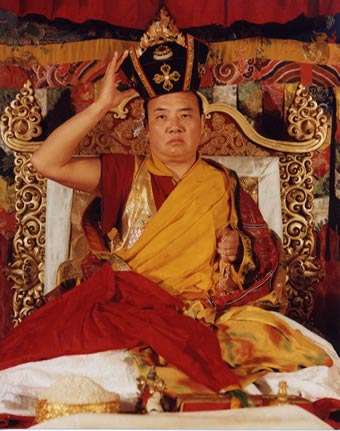
The 16th Karmapa, who died in 1981
There is a rumor going around that the Ogyen Trinley
Dorje left Tibet/China to take the black hat and other belongings of the
16th Karmapa and return to Tibet/China. It is a bit strange why he left
Tibet. He himself claims that he was living in a golden cage (he was living
a good life as the Chinese were treating him well. By all accounts, the
14-year-old led a rather pampered existence in Tibet complete with toys,
chauffeured limousines and trips through China. Trinley Dorje was particularly
valuable to the Chinese bureaucracy, as he was the only high lama recognized
by both the Dalai Lama and Beijing.) He jumped out of his window into a
waiting car and with two experienced drivers, his sister and several other
passengers sped off to the border of Nepal. Details of the journey into
Nepal then onto New Delhi vary widely—many include a romantic ride on horseback,
some the more prosaic use of public transport and others the possibility
that he and his party simply caught commercial airline flights from the
Nepalese city of Pokhara. How the car managed to evade Chinese security
within Tibet, how he and his group were able to cross two international
borders without passports or papers; and where he obtained a car and the
necessary money in the first place; all of this is left somewhat hazy.
One might think that Ogyen Trinley Dorje, the Karmapa chosen by the
Dalai Lama might have an easy path. But it turns out different. Ogyen Trinley
Dorje was born and grew up in Tibet, and was also approved to be the Karmapa
by the Chinese government. So the Indian government is very suspicious why
he fled Tibet and came to India. Since his journey into exile, the lama
has only been given permission by the Indian authorities to travel on pilgrimages
to holy places. And he is banned from traveling to his goal, Rumtek, in
Sikkim, a small Himalayan state under Indian administration but claimed
by China.
More problems: In 2003 a bitter legal contest over the assets
of Rumtek monastery has resulted in an unfavorable verdict. An Indian court
in Sikkim ruled that the assets of Rumtek belong to the Karmapa Charitable
Trust, set up by the late 16th Karmapa. The trustees support Thaye Dorje,
whom they say has the right to take over the monastery. Urgyen Trinley's
followers, whose monks currently occupy the premises, made an appeal to
the Supreme Court which they lost.
Well, if by now you have lost track
of what it is all about, look at the historical Buddha. He left his wealth,
political power and palace, and lived in utter simplicity.
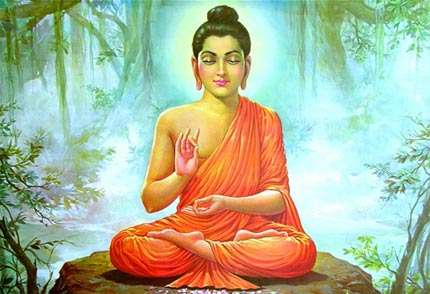
|


